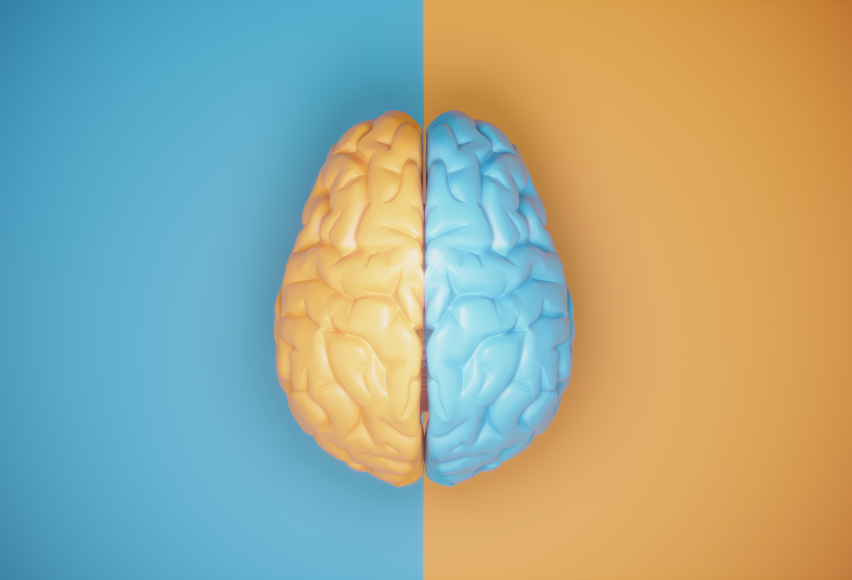
Online test
Find out the severity of your symptoms with this free online test
Obsessive-Compulsive Disorder (OCD) is a complex and often debilitating mental health disorder characterized by persistent, intrusive thoughts (obsessions) and repetitive behaviors or mental acts (compulsions) performed to alleviate the distress the obsessions can cause. Just what causes OCD is not fully understood. It is widely thought that some combination of neurobiological, genetic, and environmental factors may be responsible.
Recent advances in neurobiological imaging offer a glimpse into brain function and structure. Research suggests that brain structure and function play a crucial role in the development and manifestation of OCD.
The Neurological Basis of OCD: Brain Structure and Function
Neuroimaging studies have consistently shown structural and functional abnormalities in specific brain areas in people with OCD. One of the most widely recognized areas of the brain thought to be related to OCD is a neuropathway known as the Cortico-Striato-Thalamo-Cortical (CSTC) Circuit.
The CSTC Circuit
Simply put, the CSTC circuit is like a communication highway in the brain. It connects different areas to help with decision-making, controlling movements, and managing emotions. Think of it as a system that keeps your brain's "traffic" flowing smoothly, so you can focus, act, and respond appropriately to situations. When this loop doesn't work well, it can lead to issues like obsessive thoughts or difficulty controlling impulses.Key areas in this complex circuit include:
- Orbitofrontal Cortex (OFC): The OFC, a region in the frontal lobe of the brain, is the “thinker”. It processes information, makes decisions, and plans actions.
- Anterior Cingulate Cortex (ACC): The ACC is akin to an “error detector”, letting your brain know when you need to adjust or change an action. It’s a unique area of the brain that is connected to both the “emotional” limbic system and the “cognitive” prefrontal cortex. It plays a role in focus and motivation, decision decision-making, and emotional regulation.
- Striatum: The striatum is the “gatekeeper” in the loop. It decides what information to let through and what to block. This deep-brain structure is involved in motor control, habit formation, social interactions, and reward processing.
- Thalamus: The thalamus, located in the middle of your brain, is known as the “relay station” for all incoming motor and sensory information (except smell) on its way to the cerebral cortex for interpretation. The thalamus is also involved in sleep, wakefulness, consciousness, learning and memory.
The CSTC has been found to play a role in neuromodulation in disorders including Parkinson’s disease, OCD, and Tourette’s.
For people with OCD, research suggests that hyperactivity in the CSTC circuit leads to an inability to suppress intrusive thoughts, creating a cycle of obsessions and compulsions. This overactivity is believed to result from impaired communication between these regions, particularly heightened sensitivity in the OFC and ACC, making it difficult to "turn off" intrusive thoughts.
Neurotransmitter Imbalances
Neurotransmitters are the chemical messengers of the brain. They are a critical component in modulating the CSTC circuit's activity. When they are out of balance, the brain’s ability to function is compromised.
Research suggests that neurotransmitters play a significant role in OCD. Key neurotransmitters thought to be implicated in OCD include:
Serotonin: Serotonin plays a key role in mood regulation, anxiety, and impulse control. There is evidence to suggest that serotonin dysregulation may play a role in OCD, but that connection is not fully understood. What is known is that SSRIs (Selective Serotonin Reuptake Inhibitors) seem to be helpful in treating the disorder.
Dopamine: Associated with reward and motivation, dopamine imbalances may contribute to the compulsive and repetitive behaviors seen in OCD. While less researched than serotonin, abnormalities in dopamine signaling have been observed in OCD patients.
Other neurotransmitters thought to be involved in OCD include glutamate and GABA (γ-aminobutyric acid). Dysfunction in these neurotransmitters appears to affect inhibitory processes, possibly contributing to symptom severity.
Structural Abnormalities
Advancements in neuroimaging have provided insights into structural differences, particularly in the brain matter of persons with OCD:
Grey Matter Abnormalities: Grey matter plays a crucial role throughout the nervous system and has the largest concentration of neurons (nerve cells), axon terminals (ends) and dendrites. It is responsible for, among other things, controlling movement, memory and emotional regulation. Studies have found that the brains of people with OCD have abnormal grey matter volume, potentially affecting neurotransmitter function and impairing the ability to regulate intrusive thoughts and compulsions.
White Matter Abnormalities: The brain’s white matter is found deeper in the brain than grey matter and holds the nerve fibers (axons) of the neurons (nerve cells). It’s a sort of information station, connecting regions sending and receiving information, and critical for efficient communication between different brain regions. Abnormalities in white matter have been found in people with OCD in areas that may affect transmission of information.
Supporting Your Brain Health
Of course, the brain isn’t solely to blame for OCD. Other factors, including genetics and environmental factors, are thought to play key roles too. Still, there are things you can do as part of treatment for OCD to support brain health and functioning:
Medications
While there is no single medication used to treat OCD, SSRIs (Selective Serotonin Reuptake Inhibitors) are a widely-accepted intervention sometimes used as part of treatment for OCD. SSRIs work by increasing serotonin levels in the brain and help to reduce the intensity of obsessions and compulsions. For some, combining SSRIs with other medications may be helpful.
Exposure and Response Prevention (ERP)
ERP, sometimes referred to as the “gold standard” for treating OCD, is a specialized form of cognitive behavioral therapy (CBT) developed specifically for treating OCD. ERP involves gradual exposure to a feared stimuli while preventing compulsive responses. This technique helps retrain the brain to tolerate distress and reduce compulsive behaviors. ERP is highly effective in treating OCD.
Cognitive Behavioral Therapy (CBT)
One important aspect of CBT that is helpful for OCD is a strategy known as cognitive restructuring. Cognitive restructuring is a process of identifying and challenging unhelpful or maladaptive thought patterns that result in unwanted behaviors. Challenging and changing those patterns of thinking can promote more positive ways of thinking and support more positive decision-making and behavior.
Neuromodulation Techniques
Neuromodulation involves changing the way the brain functions by altering nerve activity in certain areas of the brain to promote healthy nerve activity. One of the most widely used of the various neuromodulation technologies that focus on directly influencing brain activity to alleviate OCD symptoms is deep Transcranial Magnetic Stimulation (dTMS).
dTMS is a non-invasive procedure that uses magnetic fields to stimulate specific areas of the cerebral cortex, reducing hyperactivity in those areas. It is currently FDA-approved for OCD and some other mental health disorders. Studies have found that 45-55% of people undergoing TMS reported reduced symptoms of OCD at one month.
Lifestyle Management
Taking care of your physical and mental health can also help you to manage your OCD symptoms. Some things you can do to practice a healthy lifestyle include:
- Stress management – Practicing relaxation and mindfulness can help reduce stress and reduce the impact of intrusive thoughts.
- Regular exercise - Regular physical activity boosts serotonin and dopamine levels, enhancing mood and reducing anxiety.
- Sleep Hygiene – Sleep is essential for overall well-being and has been linked to symptom management in OCD. Getting quality sleep also helps your brain operate at its best.
- Health Diet – A healthy diet can help you to get the nutrients your body needs to function optimally.
Conclusion
As researchers learn more about how the brain functions in someone with OCD, emerging interventions like TMS, along with current medications and therapies, offer promising new ways to treat OCD. While understanding the brain and its role in OCD remains a focus of research, it’s important to remember that genetic and environmental factors play a role as well, and that there are things you can do to promote optimal physical and mental health.
If you’re curious about ways to treat your OCD, help is available. Our therapists are specially trained in treating OCD and can help you find the best course of treatment for your unique needs. Click here to learn more about the StopOCD program and take the free test to check your symptom severity. The path to healing awaits.
References
1. Huey, E. D., Zahn, R., Krueger, F., Moll, J., Kapogiannis, D., Wassermann, E. M., & Grafman, J. (2008). A psychological and neuroanatomical model of obsessive-compulsive disorder. The Journal of neuropsychiatry and clinical neurosciences, 20(4), 390–408. https://pmc.ncbi.nlm.nih.gov/articles/PMC4476073/
2. Rădulescu, A., Herron, J., Kennedy, C., & Scimemi, A. (2017). Global and local excitation and inhibition shape the dynamics of the cortico-striatal-thalamo-cortical pathway. Scientific Reports, 7(1). https://www.nature.com/articles/s41598-017-07527-8
3. Anterior Cingulate cortex: Unique role in cognition and emotion. (2011, April 1). The Journal of Neuropsychiatry and Clinical Neurosciences. https://psychiatryonline.org/doi/10.1176/jnp.23.2.jnp121
4. Fukaya, C., & Yamamoto, T. (2016). Neuromodulation : Cortico-striato-thalamo-cortical loop dysfunction and treatment. Japanese Journal of Neurosurgery, 25(2), 137-142. https://www.jstage.jst.go.jp/article/jcns/25/2/25_137/_article
5. Striatum. (n.d.). Science Direct. https://www.sciencedirect.com/topics/medicine-and-dentistry/striatum
6. Thalamus: What it is, function & disorders. (n.d.). Cleveland Clinic. https://my.clevelandclinic.org/health/body/22652-thalamus
7. Calzà, J., Gürsel, D. A., Schmitz-Koep, B., Bremer, B., Reinholz, L., Berberich, G., & Koch, K. (2019). Altered Cortico-Striatal Functional Connectivity During Resting State in Obsessive-Compulsive Disorder. Frontiers in psychiatry, 10, 319. https://pmc.ncbi.nlm.nih.gov/articles/PMC6524661/
8. Van Dijk, A., Klompmakers, A., & Denys, D. (2008). Role of Serotonin in Obsessive–Compulsive Disorder. Future Neurology, 3(5), 589-603. https://www.tandfonline.com/doi/full/10.2217/14796708.3.5.589
9. Seiler, J. L., Cosme, C. V., Sherathiya, V. N., Schaid, M. D., Bianco, J. M., Bridgemohan, A. S., & Lerner, T. N. (2022). Dopamine signaling in the dorsomedial striatum promotes compulsive behavior. Current Biology, 32(5), 1175-1188.e5. https://www.cell.com/current-biology/fulltext/S0960-9822(22)00117-8
10. Zhang, Z., Fan, Q., Bai, Y., Wang, Z., Zhang, H., & Xiao, Z. (2016). Brain Gamma-Aminobutyric Acid (GABA) Concentration of the Prefrontal Lobe in Unmedicated Patients with Obsessive-Compulsive Disorder: A Research of Magnetic Resonance Spectroscopy. Shanghai archives of psychiatry, 28(5), 263–270. https://pmc.ncbi.nlm.nih.gov/articles/PMC5434282/
11. Li, B., Lin, Y., Ren, C., Cheng, J., Zhang, Y., & Han, S. (2024). Gray matter volume abnormalities in obsessive-compulsive disorder correlate with molecular and transcriptional profiles. Journal of Affective Disorders, 344, 182-190. https://www.sciencedirect.com/science/article/abs/pii/S0165032723012569
12. Gan, J., Zhong, M., Fan, J., Liu, W., Niu, C., Cai, S., Zou, L., Wang, Y., Wang, Y., Tan, C., Chan, R. C., & Zhu, X. (2017). Abnormal white matter structural connectivity in adults with obsessive-compulsive disorder. Translational psychiatry, 7(3), e1062. https://pmc.ncbi.nlm.nih.gov/articles/PMC5416668/
13. Kellner, M. (2010). Drug treatment of obsessive-compulsive disorder . Dialogues in Clinical Neuroscience, 12(2), 187–197. https://www.tandfonline.com/doi/full/10.31887/DCNS.2010.12.2/mkellner
14. Hezel, D. M., & Simpson, H. B. (2019). Exposure and response prevention for obsessive-compulsive disorder: A review and new directions. Indian journal of psychiatry, 61(Suppl 1), S85–S92. https://pmc.ncbi.nlm.nih.gov/articles/PMC6343408/
15. Van Noppen, B., Sassano-Higgins, S., Appasani, R., & Sapp, F. (2021). Cognitive-Behavioral Therapy for Obsessive-Compulsive Disorder: 2021 Update. Focus (American Psychiatric Publishing), 19(4), 430–443. https://pmc.ncbi.nlm.nih.gov/articles/PMC9063577/
16. Transcranial Magnetic Stimulation (TMS) for OCD. (n.d.). https://iocdf.org/about-ocd/treatment/tms/
15. Brierley, M. E., Thompson, E. M., Albertella, L., & Fontenelle, L. F. (2021). Lifestyle Interventions in the Treatment of Obsessive-Compulsive and Related Disorders: A Systematic Review. Psychosomatic medicine, 83(8), 817–833. https://pubmed.ncbi.nlm.nih.gov/34334731/
16. Segalàs, C., Labad, J., Salvat-Pujol, N. et al. (2021). Sleep disturbances in obsessive-compulsive disorder: influence of depression symptoms and trait anxiety. BMC Psychiatry 21, 42. https://bmcpsychiatry.biomedcentral.com/articles/10.1186/s12888-021-03038-z
Online test
Find out the severity of your symptoms with this free online test
Start your journey with StopOCD
Take control of your life and find freedom from OCD through professional therapy and evidence-based cognitive behavioral techniques.
Start Now



